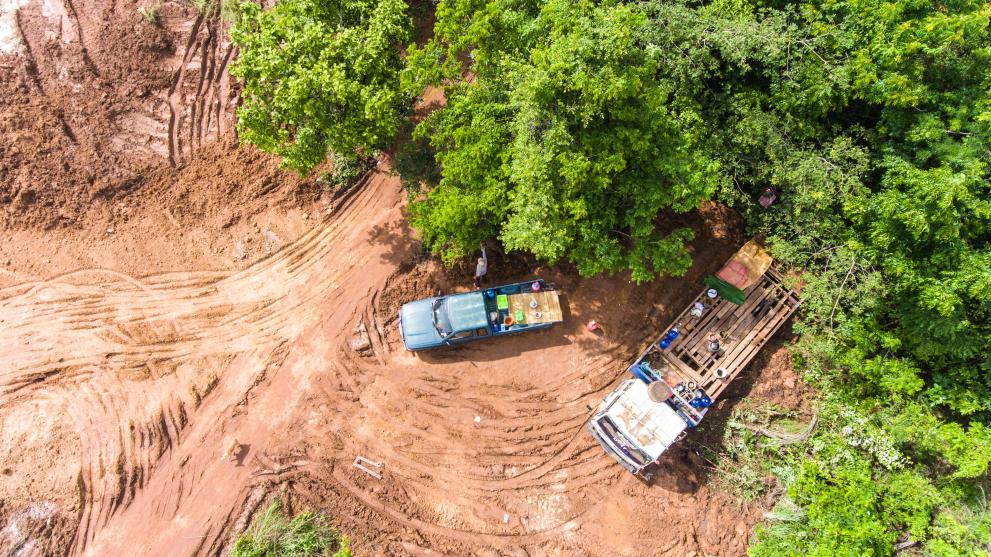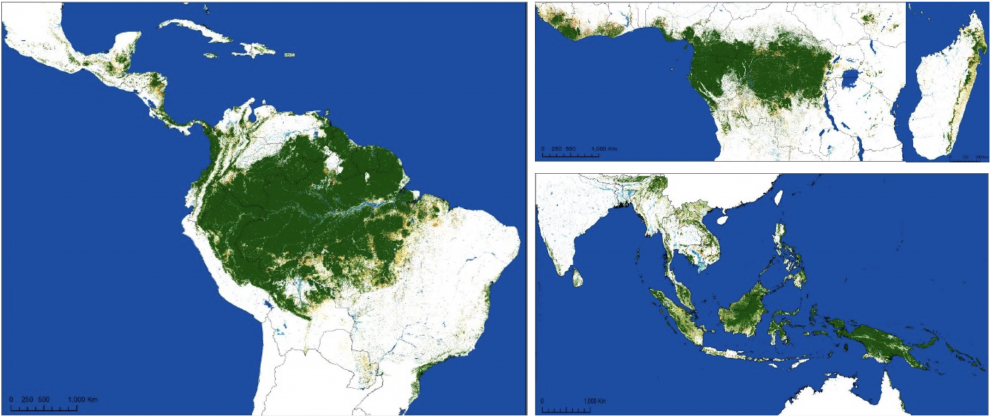
A new JRC publication in Science Advances provides unique information on tropical moist forest cover disturbances through an unprecedented dataset of maps of deforestation and degradation at fine spatial resolution covering the past three decades.
Summary
- An estimated 17% of tropical moist forests have been lost to agriculture and other land uses since 1990, leaving a remaining area of 1,071 million ha in 2019, of which 10% is degraded.
- Accurate characterisation of tropical moist forest changes is needed to support conservation policies and to quantify their contribution to global carbon fluxes more effectively.
- A recent JRC study documents – at pantropical scale – the extent of and changes (degradation, deforestation and recovery) to these forests over the past three decades.
- Another recent JRC-co-authored paper shows the importance of carbon losses due to tropical forest fragmentation within the Amazon Basin that are not yet accounted for in global carbon budgets.
- JRC participation in the AAAS 2021 examined opportunities for climate change mitigation through the protection and restoration of tropical moist forests.
Deforestation and forest degradation are major threats to climate and biodiversity
In recent decades, human activities have led to deforestation, landscape fragmentation, global warming and greater frequency of natural hazards.
Tropical forests sequester about half of the global terrestrial carbon uptake, removing about 15% of anthropogenic carbon dioxide emissions from the atmosphere.
Carbon emissions from land use and land-use change, mostly due to tropical deforestation, are the second biggest cause of climate change after fossil carbon dioxide (CO2) emissions. The continued degradation of forests threatens biodiversity and the survival of many species, and exacerbates global warming.
Deforestation is the primary driver of forest carbon loss in tropical forest ecosystems, but other disturbances in these ecosystems - such as degradation and fragmentation - also contribute significantly to carbon emissions.
Monitoring tropical forest areas and their intactness is therefore crucial for sustainable development, particularly in the context of the European Green Deal.
Loss of intact tropical humid forests
Carbon losses due to degradation and fragmentation of tropical forest cover have, to date, been underestimated. To improve understanding of these threats, scientists are turning to Earth observation.
The use of Earth observation data enables accurate monitoring of deforestation due to agriculture, degradation from logging and fires, and fragmentation of forest landscapes. Free and open access datasets of satellite imagery, innovative remote sensing approaches and increased capacities to process large amounts of data all improve the research communities’ capacity to study these threatened ecosystems.
The JRC article published on 5 March provides new information about tropical moist forest cover dynamics through an unprecedented comprehensive dataset of moist forest that covers the past three decades at fine spatial resolution.

For the first time at the pan-tropical scale, the dataset identifies forest degradation in addition to deforestation and post-disturbances development stages. This study underlines the importance of the degradation process in such ecosystems.
According to the article, an estimated 17% of tropical moist forests have been lost to agriculture and other land uses since 1990. Of the 1,071 million ha remaining in 2019, 10% is degraded.
Using a buffer zone of 120 m from the detected disturbed pixels (to exclude the potentially edge-affected forest areas), the total area of degraded forests and edge-affected forests is estimated at 398 million ha, which represents 37% of the entire remaining forested area in 2019.
The authors call for urgent action to safeguard tropical humid forests that are being subjected to alarming rates of deforestation and degradation. The methodology used to analyse the data is described in a JRC Technical Report (Long-term monitoring of tropical moist forest extent (from 1990 to 2019)).
Fragmentation of tropical forests leads to loss of carbon and biodiversity
As forests harbour most land-based plant and animal species, safeguarding woodland holds the key to protecting global biodiversity.
The latest State of the World’s Forests report (SOFO 2020) shows that forests contain 60,000 different tree species, 80% of all amphibian species, 75% of all bird species, and 68% of all mammal species on Earth. Their well-being and survival depend on the quality and intactness of the forest habitat.
Forest fragmentation – the division of continuous habitat into smaller and more isolated fragments – represents a serious threat to the integrity of ecosystems and biodiversity.
Forest fragmentation is the result of ever-increasing pressure on anthropogenic land use. The activity has been established as a Sustainable Development Goal (SDG) indicator for SDG 15 “Life on Land”, to help locate and measure various degrees of forest fragmentation at the global scale.
Another Science Advances paper co-authored by the JRC used an innovative remote sensing approach to estimate the carbon loss due to forest fragmentation within the Amazon Basin.
It found that forest fragmentation in the early 21st century was responsible for a third of the carbon loss caused by deforestation in Amazonia. Brazil accounted for two thirds of the Amazon Basin’s carbon loss by forest fragmentation.
Participation at the AAAS 2021
The theme of the 2021 Annual Meeting of the American Association for the Advancement of Science (AAAS) focused on understanding the complexities and dynamics of various ecosystems by drawing on a multitude of perspectives.
The outcomes of the two papers in Science Advances were presented during a live session entitled “Dynamics of Tropical Forests and Their Impact on the Climate” during the 2021 Annual Meeting.
The speakers in this session examined opportunities for climate change mitigation through protection and restoration of moist tropical forests. The third speaker demonstrated how restoration of degraded tropical lands can be an effective additional defence in our battle against climate change, and afforestation can help to reduce the pressure on natural forests. However, they also pointed out that newly planted forests cannot replace intact forests.
Related Content
Long-term (1990–2019) monitoring of forest cover changes in the humid tropics
JRC Technical Report: Long-term monitoring of tropical moist forest extent (from 1990 to 2019).
EU Communication (2019) on Stepping up EU Action to Protect and Restore the World’s Forests
Cirad press release (in French)
AAAS-2021Session on “Dynamics of Tropical Forests and Their Impact on the Climate“
The global tree restoration potential
State of the World’s Forests – forests, biodiversity and people
Details
- Publication date
- 8 March 2021
